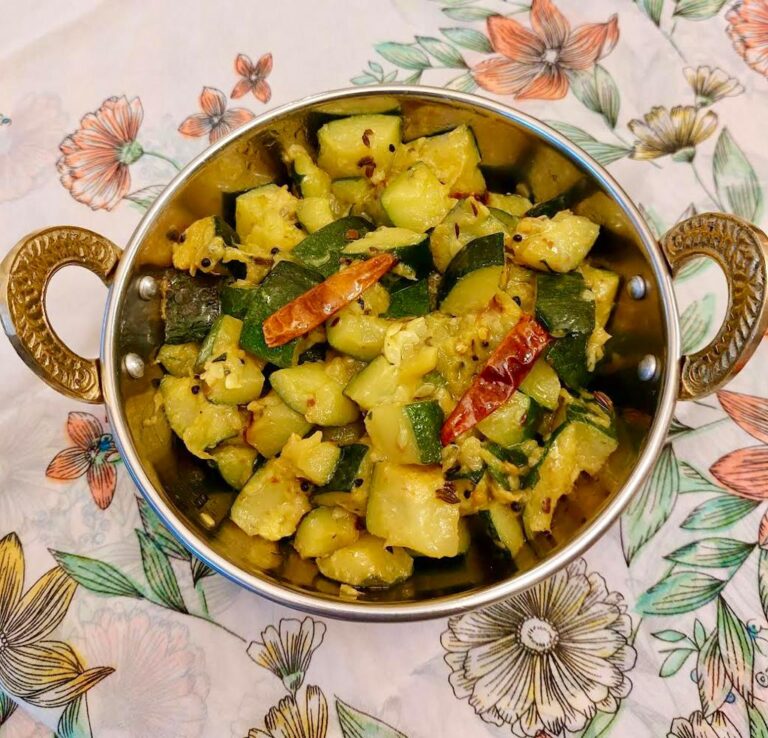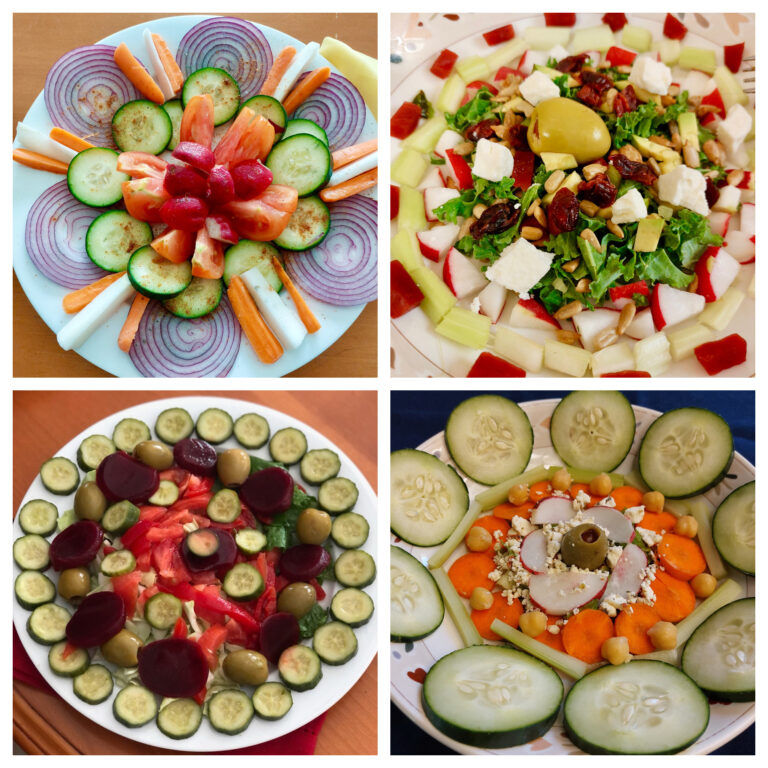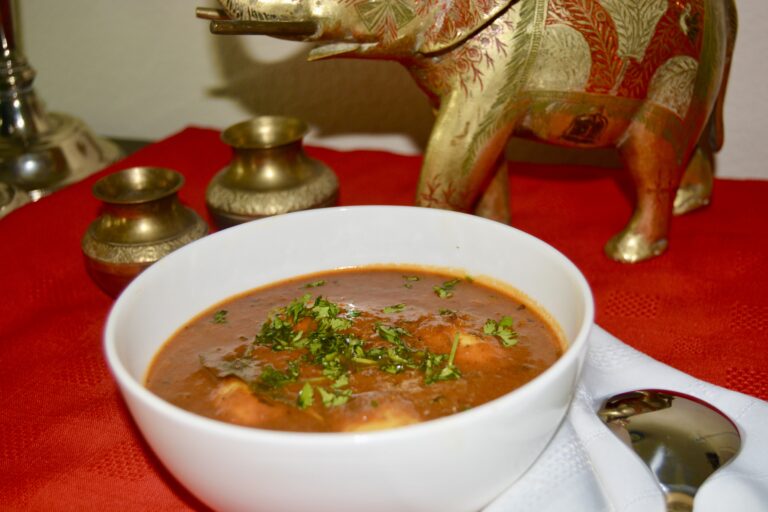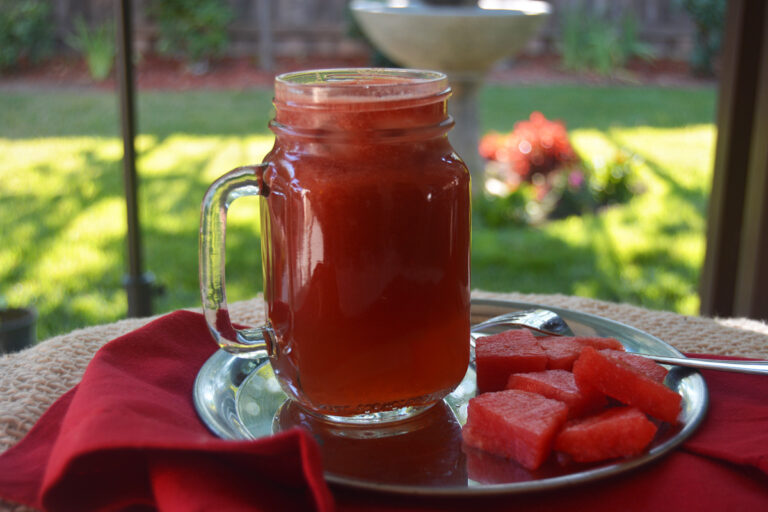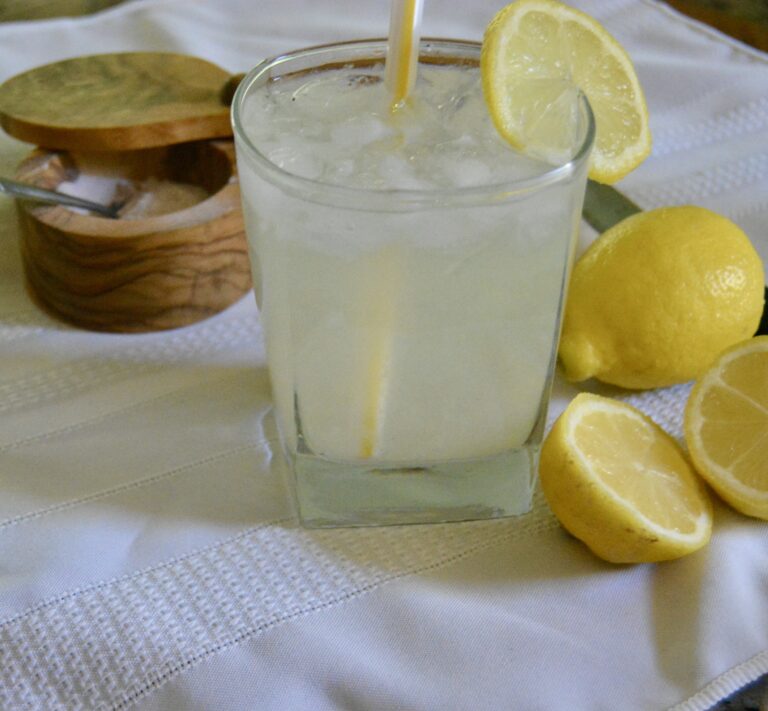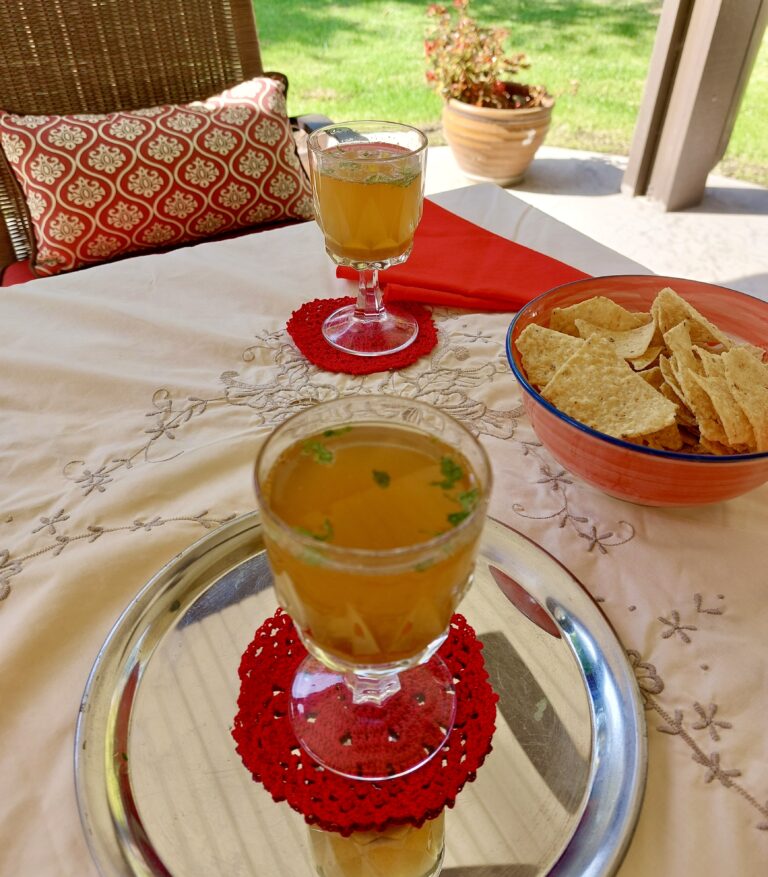We are back from a ten-day vacation. My vegetable garden is relatively new, and I am anxious to check how it has fared with only the timed sprinklers watering it.
Not bad!
The plants are still alive, and the two zucchini plants I cultivated are spread thickly over the plot. Peeping out from under the foliage, I spy a bit of zucchini. I pull at the fruit. It is over one foot long. It is the largest I have seen, and it has a companion. These were just beginning to grow when we left on our trip. That’s when I learned that zucchini grows very fast, so it’s a good idea to keep an eye on them when they grow so you can harvest them young and tender.
The Indian equivalent of zucchini is a gourd called Toree. It has a mild, slightly sweet flavor. Like most squashes, it takes on the flavor of the seasonings and spices it is cooked in.
I cook zucchini with a five-seed seasoning called panch pooran (five seeds). I add a little heat to this dish to counter the slight sweetness of the zucchini. Panch Pooran seasoning is available at Indian grocery stores, but I have included a recipe for it in the notes. It goes good with squashes and cabbage.
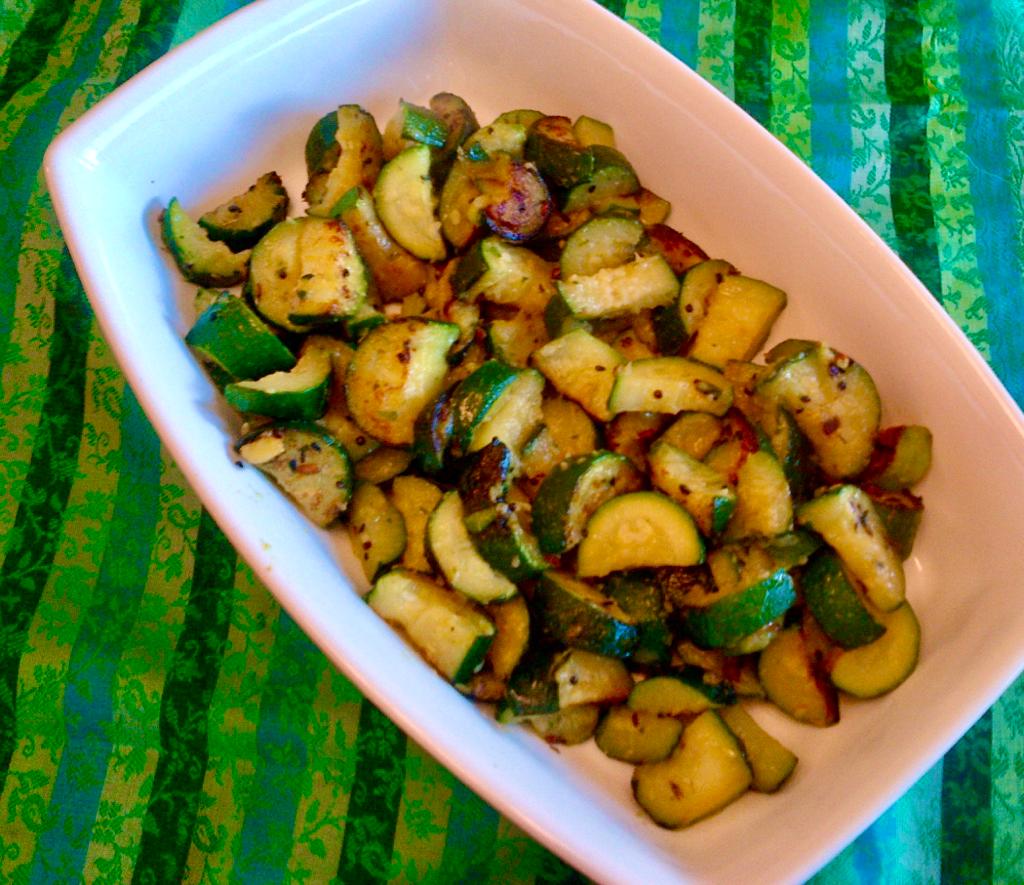
Tori Panch Pooran Sabzi (Five-Seed Zucchini Vegetable)
Ingredients
- 4-6 medium zucchini
- 1 tsp 5-seed seasoning
- 1-2 small dry red chilies (more or less, to your taste)
- ¼ tsp red chili flakes (more or less, to your taste)
- ½ tsp turmeric powder
- ½ tsp salt (more or less, to your taste)
- 2 tbsp cooking oil
Panch Pooran Tadka
- 1 tsp mustard seeds
- 1 tsp coriander seeds
- 1 tsp fennel seeds
- ½ tsp fenugreek seeds
- ½ tsp onion seeds (you can substitute 1 tsp cumin seeds for the onion sees.)
Instructions
- Wash the zucchini. Cut the stalk end. Split the zucchini in half length-wise and then again in half length-wise. Chop into bite-sized bits. Don't cut the bits too small, as they get squishy fast.
- In a wok or skillet, heat the oil on medium heat. Lower heat to medium-low and add the red chilies, give them a stir, and let them darken for about 30 seconds. They are pungent, so don't inhale, or you will start coughing!
- Add the five-seed seasoning, wait 30 seconds for it to crackle and pop, then quickly add the turmeric powder.
- Stir for a few seconds before adding the zucchini.
- Stir until the zucchini is nicely coated.
- Turn the heat up to medium and cook uncovered, stirring occasionally, until the zucchini is done(approximately 10-15 minutes).
- You can leave the vegetable crunchy or soft to your liking. You do not have to add water as the zucchini releases enough moisture to cook in.
- This dish goes well in a wrap or as a side with roti, dal, or rice.
Panch Pooran Tadka
- Toss all the ingredients together and store them in ajar.
- Fenugreek is a bitter seed; if you are not used to it, you can reduce it to 1/4 teaspoon.
- Panch Pooran can be used when fixing different squashes and cabbage.
Notes
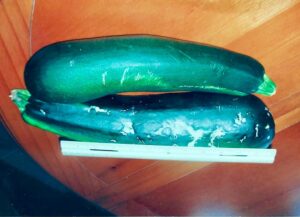
Salads are always a part of an Indian meal, especially during the hot summer months. Most are a medley of fresh vegetables tossed with a splash of lemon juice and a sprinkling of your choice of exotic and aromatic spice powders.
Salads are more elaborate for parties, with vegetables cut in the form of flowers, plants, bird plumes, etc. Indian salads with a simple dressing pair well with curries, dals, sabzis, and rice dishes.
Indian salads include Kachumber (a combination of chopped onions, tomatoes, cucumber, and green chilies), veggies like cucumber and potato mixed with yogurt, and Kachumber Raita (Kachumber mixed with yogurt).
As access to cooking videos via social media has grown exponentially. Salads in urban areas of India have also started to include more Western style salads and dressings. Boiled chickpeas, black beans, sprouted beans, paneer, cheese, and seeds like peanuts, sunflower, cashew nuts, walnuts, almonds, raisins, and pomegranate seeds have found their way into Indian salads.
If you choose to include a salad in an Indian meal you are fixing, there are no hard and fast rules! Use your palate and imagination to create your masterpiece.
Popular vegetables used in Indian salads are onions (red or yellow), boiled beetroot, cucumber, carrots, tomatoes, red radish, daikon radish (long white Japanese radish), green chilies, fresh mint, and coriander, along with a sprinkling of lemon juice
Seasoning spice powders choices for salads are black pepper, chaat masala, black salt, chili powder, and salt.
Since my hubby’s retirement, he has expanded his creative side to fixing us salads. I would be remiss if I did not include pics of some of his creations!
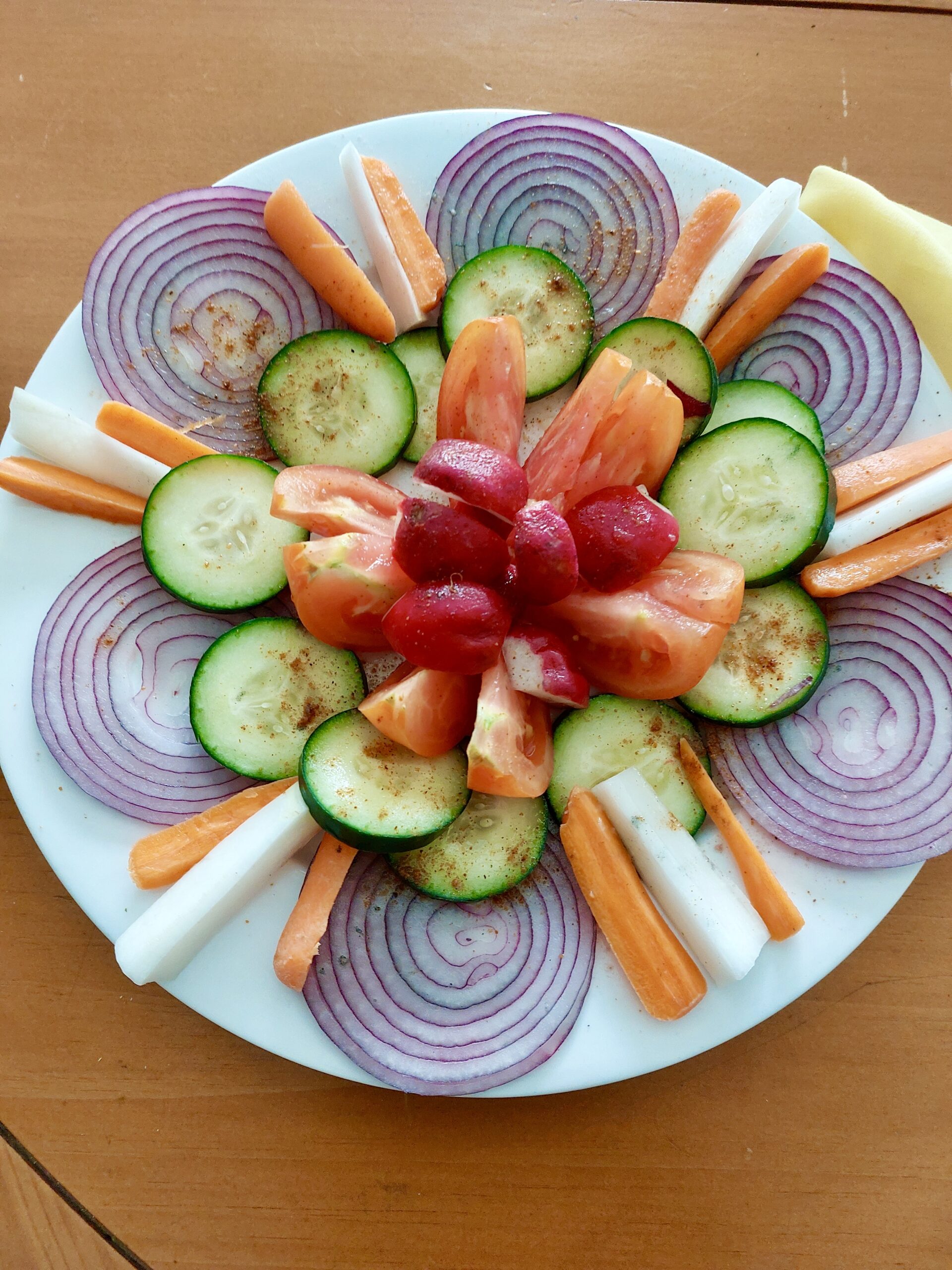
An Indian Salad
Ingredients
- ½ medium red onion
- ½ medium daikon radish (peeled, cut in half, and then into strips)
- 1 medium carrot (peeled, cut in half, and then into strips)
- 1 large tomato (sliced into 8 wedges—keep the base intact)
- 4 red radishes (greens removed, and quartered)
- 1 medium cucumber (sliced into rounds)
- ½ lemon or lime
Instructions
- On a salad or large plate, arrange the onions at the edge of the plate at spaced intervals.
- Next, layer your cucumber at the base of the onions rounds.
- Arrange your carrot and daikon strips between the onions.
- Now place your tomatoes in the center of the plate and the radish in the center of the tomatoes.
- Sprinkle lemon juice and your choice of spice powders.
Notes
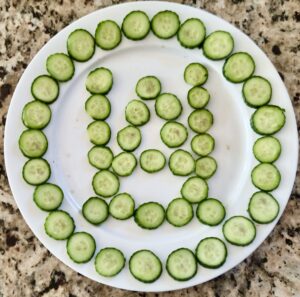
Egg curry, a tangy blend of onions, tomatoes and spices that are used as a base for boiled eggs, was a good substitute for vegetarian guests at a luncheon or dinner party. My husband, an officer in the Air Force, lived on the base (the Air Force Station). So any party one had invariably numbered over twenty guests. Buffet-style meals were the way to go, and you catered for vegetarian and non-vegetarian guests.
Egg curry was also a quick go-to to stretch the meal for unexpected lunch or dinner guests.
You can make egg curries in several ways, depending on which state in India you live in. This is the Punjabi version of the various recipes out there.
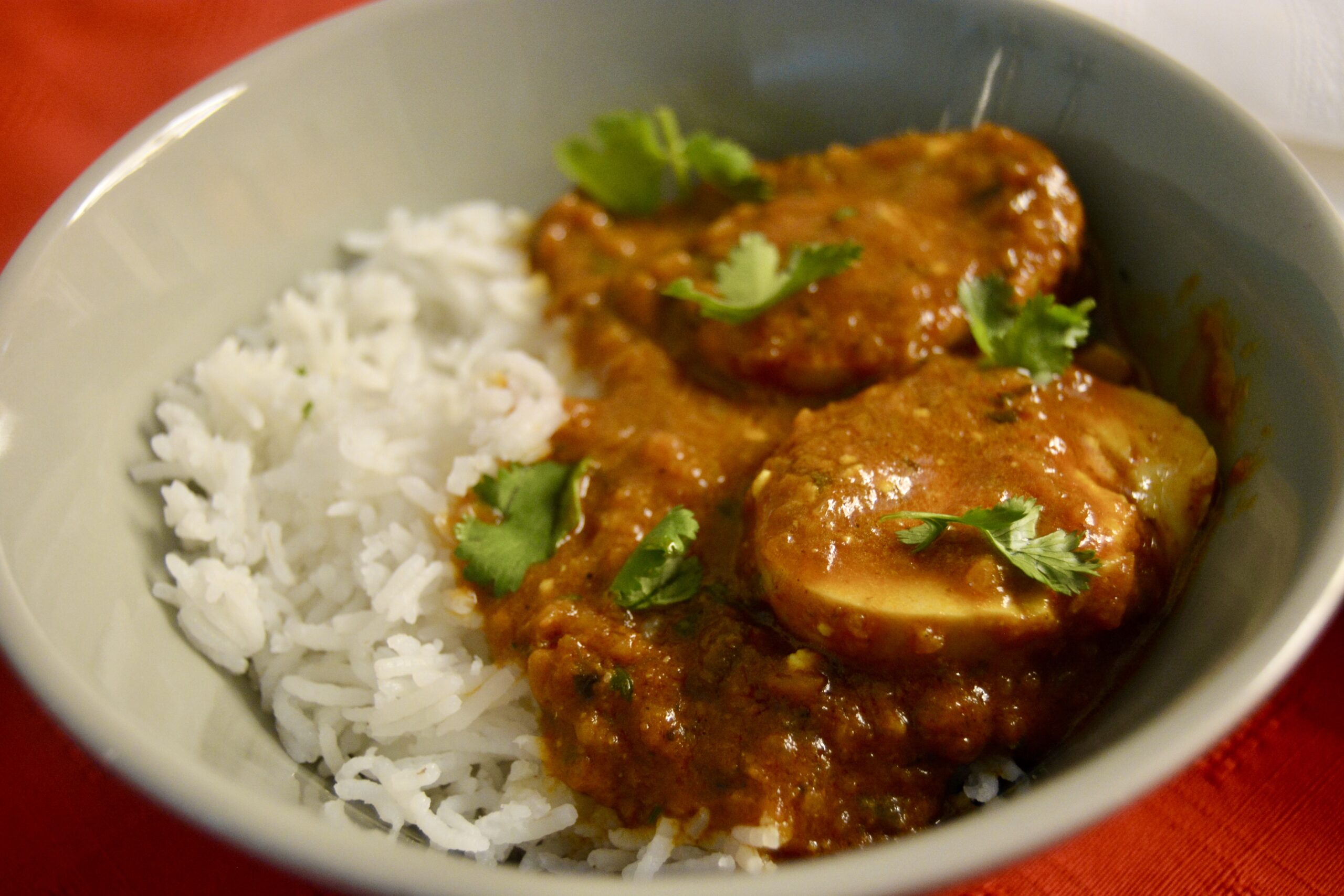
Anda ki Curry (Egg Curry)
Ingredients
- 6 eggs
- 4 tbsp cooking oil
- 2 medium Bay leaves
- 2 green cardamom
- 1 green chili, slit (more or less chili; optional—adjust to your taste)
- 2 medium yellow or red onion (chopped fine)
- 1 tbsp ginger-garlic paste
- 1 tsp turmeric powder
- 2 tsp coriander powder
- ¼ tsp red chili powder (more or less chili powder; optional—adjust to your taste)
- 2 medium tomatoes (pureed or 2 tbsp tomato paste)
- ¼ tsp cinnamon powder
- ¼ tsp clove powder
- ¼ tsp pepper powder
- 1 tsp salt (or to taste)
- 2 cups warm water
Optional
- 2 medium potatoes (quartered )
Garnish
- ½ tsp garam masala (optional )
- 2 tbsp fresh cilantro (coriander leaves) (finely chopped)
Instructions
To Boil Eggs:
- Lay the eggs at the base of a saucepan large enough to hold them. Add enough water to cover them by about 2 inches.
- On medium heat, bring the water to a rolling boil. Turn off the heat. Set aside for 10 minutes.
- After 10 minutes, transfer the eggs to a bowl of ice-cold water. Crack them slightly before immersing them. (It is easier to peel the eggs when they are cool).
- Peel, rinse and wipe the eggs dry with a paper towel. With a toothpick, carefully poke a few holes around the egg. This allows the gravy to flavor the egg. Set the boiled and peeled eggs aside.
For the Curry
- Heat the oil in a deep skillet or saucepan on medium heat. The oil should be hot, not smoking, or your spices will burn.
- Add the Bay leaves, green cardamom, and slit green chilies. Stir it.
- Add the finely chopped onion and sauté for about 7 minutes until golden.
- Add the ginger/garlic paste, turmeric, chili powder, coriander powder, and cumin powder. Stir for a minute until the ginger sticks to the pan's bottom. Be careful not to burn the masala.
- Add the tomatoes, cinnamon, clove, pepper powder, and salt. Cook, occasionally stirring, until the tomatoes are soft and the oil starts to surface—approximately 4-5 minutes.
- Add 2 cups of water and bring to a boil.
- Add potatoes to the tomato-onion mixture.
- Lower heat to medium-high and simmer for about 10 minutes until you get a thick gravy and the potatoes are done. At this point, do a taste test for salt.
- Add the eggs and let them simmer on low for another 7-10 minutes while gently rolling them around occasionally to absorb the gravy.
- Add a little more hot water if the gravy gets thicker than you prefer. Be careful not to make the gravy too watery.
- Spoon into a serving dish. You can leave the eggs whole or carefully split the eggs in half-length wise.
- Garnish with chopped cilantro.
- Serve with plain boiled rice or pilaf.
- Anda Curry also tastes good with parathas or any flatbread. I like to have it with any kind of bread to dip in the gravy. It tastes amazing!
Notes
A favorite memory: It is a hot summer’s day. This particular evening, Aunty Sheila has invited us to her place for a party. It is always fun to visit her, as we kids on both sides of the family are around the same age and have a great time together. Aunty has a warm, bubbly personality and throws great parties. Her place is not too far from ours, so, giggling and laughing, we girls walk over, we love walking—even in the heat of the day.
Hot and starting to perspire by the time we get there, our eyes light up as we see that Aunty has already set up an outdoor table of party fare. In the center is a large tray with a giant watermelon propped securely on it. Around the watermelon are other delicious treats. She greets us with her usual big smile and hug and tells us to help ourselves to some watermelon juice. We happily walk across the lawn to the table. The top quarter of the melon has been sliced out, and we peer into the cut melon. The fruit inside has been carefully carved out and then blended with cold black tea and lemonade. Chunks of melon still float around for those who want to eat the fruit. We thirstily gulp down the Watermelon Tea Cooler and help ourselves to more. The drink is so cool and refreshing on that Indian hot summer’s day.
Years later, thinking about some of my fun memories of life in India, I decided to try and duplicate the recipe. I enjoy serving this taste of memory to my family and friends who tell me that I have been successful in duplicating the recipe!
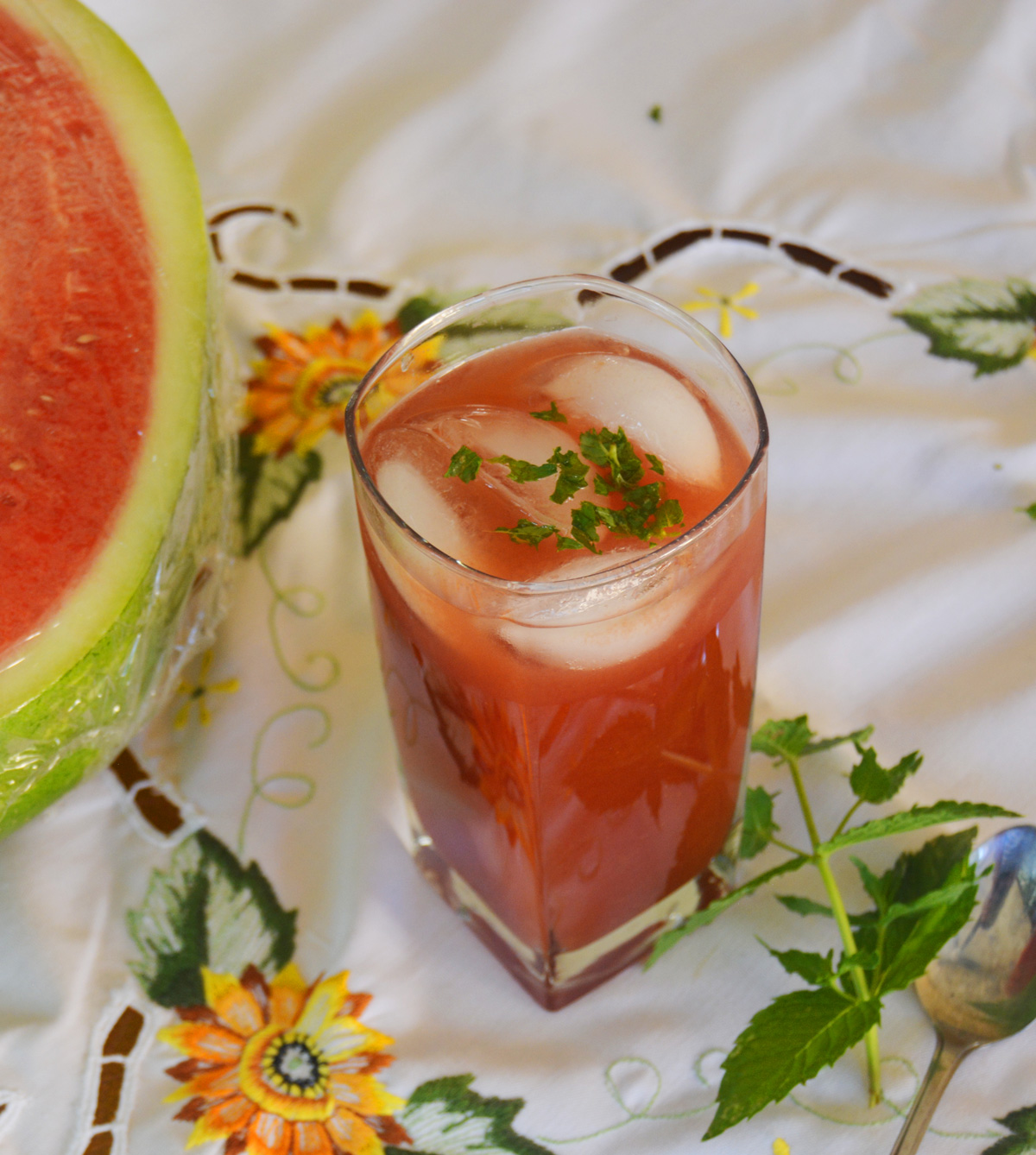
Watermelon Tea Cooler
Ingredients
- 3 tea bags black tea (your choice of brand, caffeinated or decaffeinated)
- 4 cups water
- ½ cup simple syrup (see recipe below)
- ½ cup lime or lemon juice
- 2–3 cups watermelon chunks, seeds removed
- 1 tbsp Chopped mint and lemon or melon wedges for garnish (optional)
Instructions
- Put tea bags in a container that will hold the 3 cups of water. Boil the 3 cups of water, and when they come to a boil, pour the boiling water over the teabags. Let the bags steep for at least 3 minutes. Remove the tea bags and let the tea cool.
- Once cooled, place it in the refrigerator. You can do this a day ahead or a few hours before you are going to make the cooler.
- Blend the watermelon chunks in until it is like a smoothie. In a pitcher that holds at least 6 cups of water, add the tea, simple syrup, lemon juice, and melon smoothie. Stir it all together until nicely mixed. Add some crushed ice when ready to serve.
- If it is too tangy, you can add more crushed ice or cold water.
Notes
½ cup water Directions: 1. In a saucepan, on low heat, dissolve ½ cup of sugar with ½ cup of water (approximately 3 minutes).
2. Take the saucepan off the heat and leave the syrup to cool.
3. When cool, pour the syrup into a clean glass bottle that has a tight lid.
4. Rinse the bottle both with boiling water (do not wipe with a cloth as it may leave bacteria).
5. Refrigerate the syrup until ready to use. It should last a month in the fridge. It should remain a clear liquid. If it turns cloudy, throw it out as that is a sign of bacterial growth!
6. The ratio for simple syrup is one part sugar and one part water so you can always make more to store.
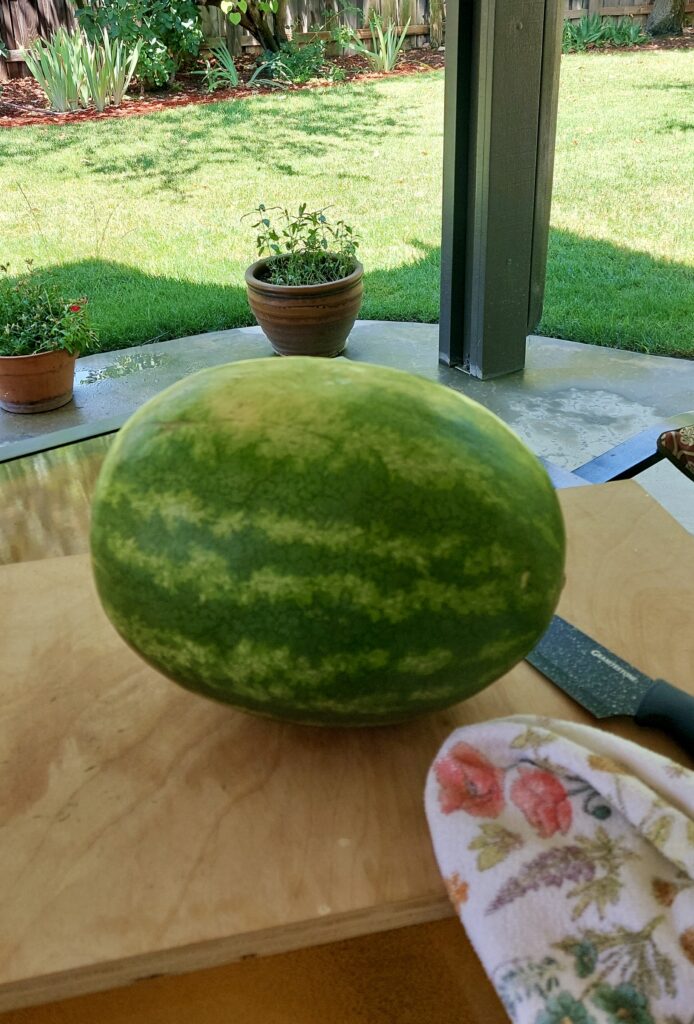
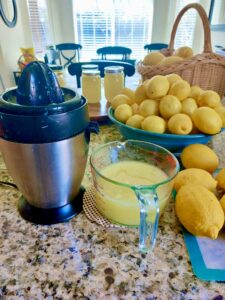 It is a hot summer’s day. I hear Rosy, our cook, fixing lemonade for our son and his friends in the kitchen. The loud spoon clinking against the glass as she vigorously stirs the sugar into the lemon and water mixture reminds me of when we were kids.
It is a hot summer’s day. I hear Rosy, our cook, fixing lemonade for our son and his friends in the kitchen. The loud spoon clinking against the glass as she vigorously stirs the sugar into the lemon and water mixture reminds me of when we were kids.
Mom homeschooled us elder ones for a short while before we started schooling in a new town. Nanny was left in charge to make sure we did not goof off. Hearing our cook Daniel fixing lemonade the same way for our ‘elevenses’ signaled that a break was coming, which we were ever ready for!
Our lemon tree at home here gives us plenty of lemons. I fix a bunch of lemonade concentrate in 8 oz glass jars and freeze them. These are time savers when needed.
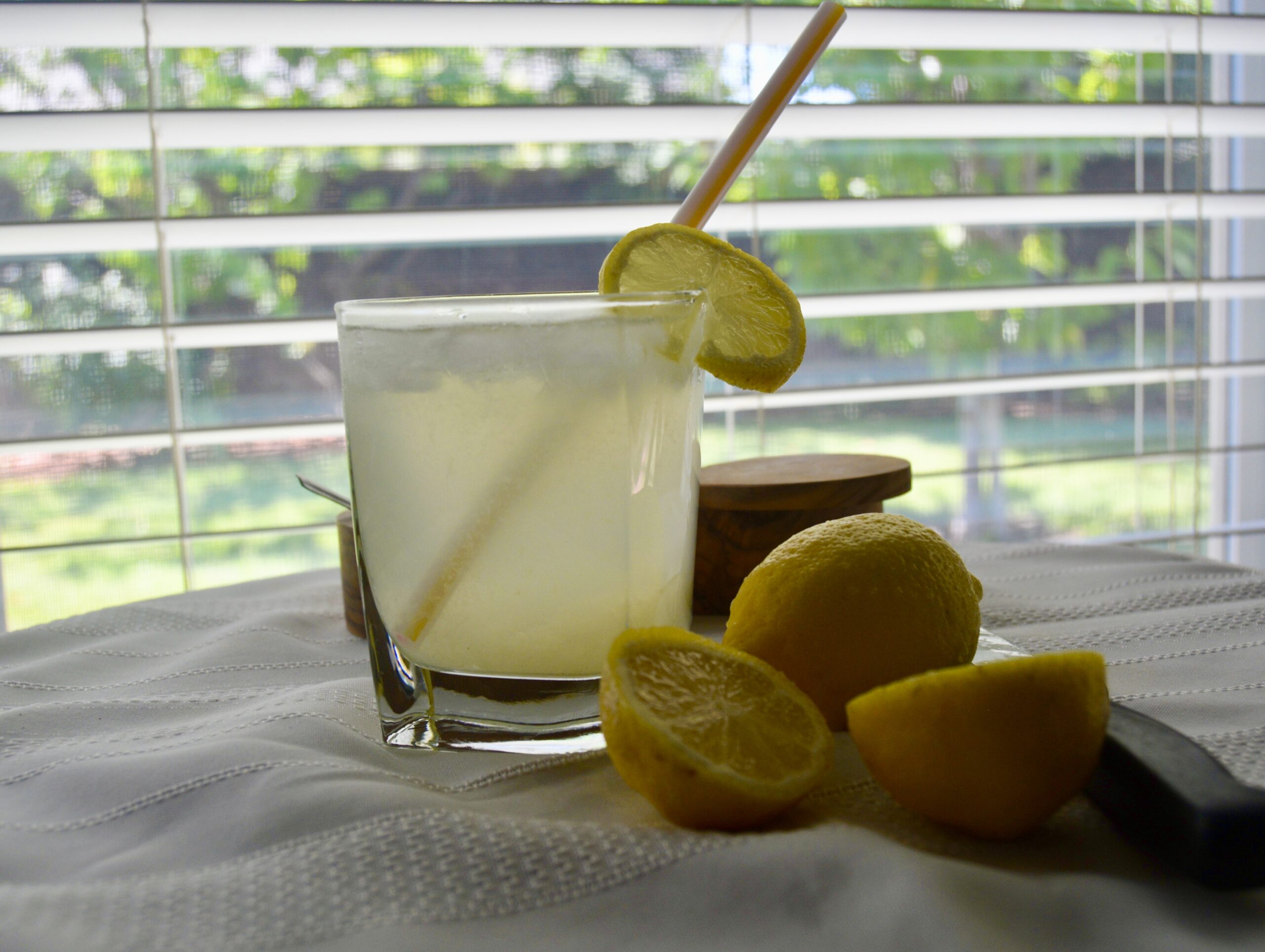
Nimbu Pani (Lemonade)
Ingredients
For the Lemonade Concentrate
- ½ cup white sugar
- ½ cup water
- 1 cup lemon juice (Remove the seeds, but keep a bit of the pulp)
To Make Lemonade
- ¼ cup lemonade concentrate
- ¾ cup water
- ice cubes (to your preference)
Instructions
- In a nonreactive 3-4 quart saucepan, dissolve the sugar and water on medium heat.
- Remove from the heat and set aside until cool. Approximately 30 minutes.
- When cool, add the lemon juice, and stir together.
- Store in an airtight glass bottle in the refrigerator. Suitable for about 10 days.
To Make Lemonade
- Mix together the lemonade concentrate, water, and ice cubes. Do a taste test! And adjust by adding more lemonade concentrate or iced water.
- Serve with a wedge of lemon or a few mint leaves.
Jal-jeera or Jeera Pani is a drink made with spicy, sweet, and tangy ingredients. Chilled, it is a refreshing drink in hot summers and has many health benefits. I got this recipe from one of the many parties we attended when my husband served in the Indian Air Force. Recipe exchanges were never precise, and you would get, “Just put a little bit of this and a little bit of that.” It was up to one to create their exotic version and adjust it to one’s taste. So, while we may have served the same drink, it always tasted a little different.
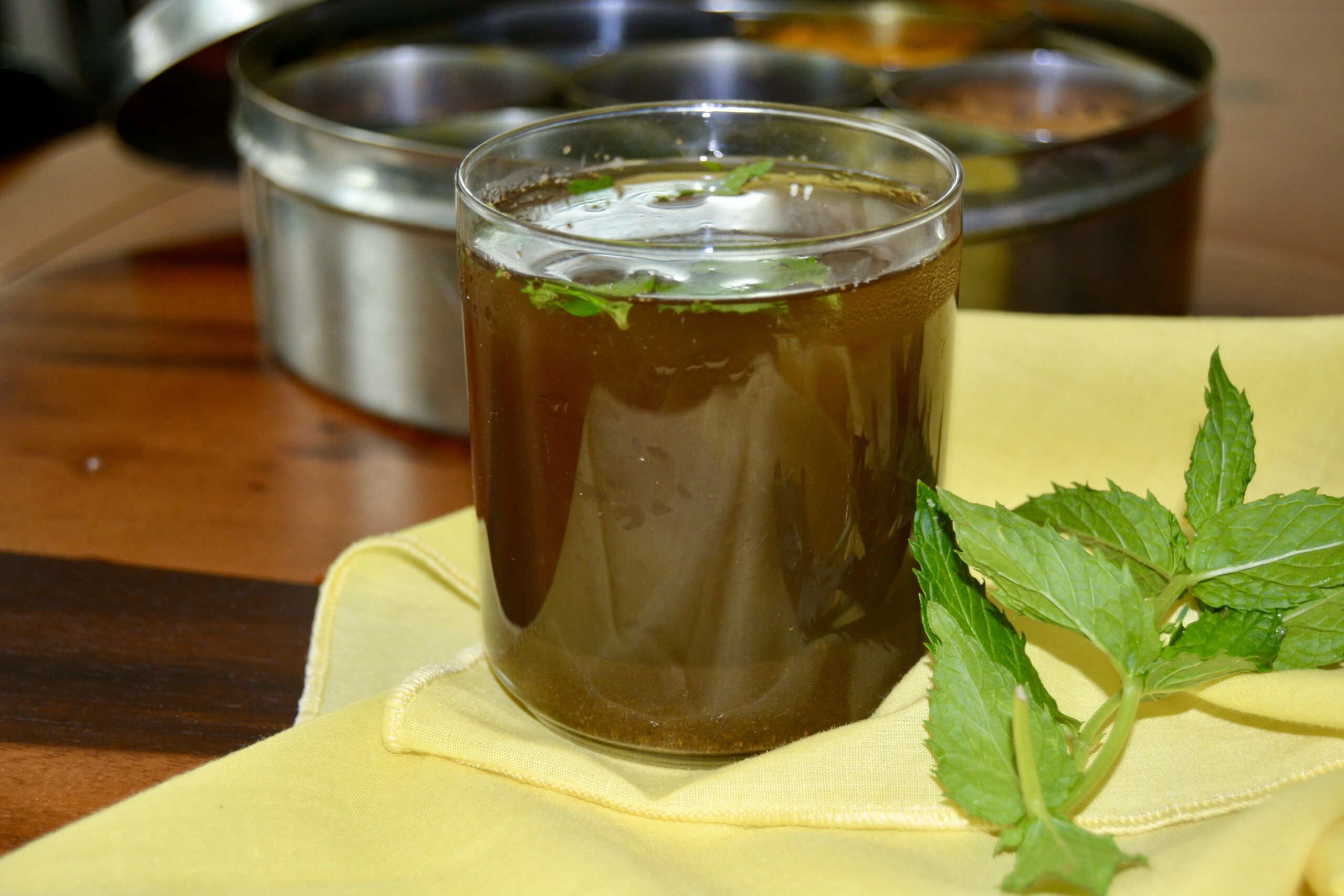
Jal-jeera (Jeera Pani) (Sweet and Spicy Cumin Water)
Ingredients
- 8 cups water
- 2 tsp dried ginger powder ("Sonth" in Hindi)
- 2 tbsp rock salt (kala namak, black salt, so called due to its darker hue—you can buy this at any Indian or health food grocery store)
- 1 tsp tamarind paste (heaped )
- 1 tsp mint paste (about 20 fresh mint leaves)
- ⅛ tsp chili powder (or to your taste)
- 1 tsp cumin powder
- 3 tbsp brown sugar or jaggery (or gur, found in Indian grocery stores)
- 1 tbsp white sugar
- 2 tsp lemon juice
- 2 tsp chaat masala (optional—found in Indian grocery stores)
- Dash of black pepper, roasted cumin, and garam masala
Instructions
- Add all the ingredients to a pan and bring to a boil on medium heat while stirring often to dissolve the sugars.
- Reduce heat to medium-low and let it simmer for 15 minutes.
- Continue to stir occasionally.
- Do a taste test. (FYI - Indians don't use the same spoon to taste and cook. It is considered 'jutha,' a word that conveys food contaminated by double dipping).
- Adjust ingredients to your taste.
- Strain the mixture into a glass jug (pitcher). Add the lemon juice. Stir and chill.
- When chilled, pour in glasses, and serve garnished with mint.

